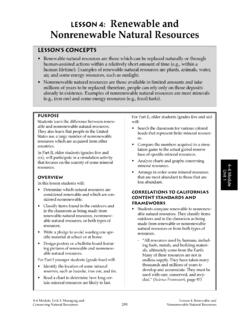Transcription of Bioswales - USDA
1 BioswalesWhat are Bioswales ? Bioswales are storm water runoff conveyance sys-tems that provide an alternative to storm can absorb low flows or carry runoff fromheavy rains to storm sewer inlets or directly to sur-face waters. Bioswales improve water quality byinfiltrating the first flush of storm water runoff andfiltering the large storm flows they majority of annual precipitation comes fromfrequent, small rain events. Much of the value ofbioswales comes from infiltrating and filteringnearly all of this a bioswaleFor best results, enhance and utilize existing natu-ral drainage swales whenever possible. Existingswales can be enhanced with native plants. Thethicker and heavier the grasses, the better theswale can filter out contaminants. Additionally,subgrade drains and amended soils may be neededto facilitate infiltration. Bioswales2 0 0 and transport large runoff eventsA bioswale featuring native vegetation shows its fall considerations when designing ormaintaining Bioswales : Costs vary greatly depending on size,plant material, and site considera-tions.
2 Bioswales are generally lessexpensive when used in place ofunderground piping. Deep-rooted native plants are pre-ferred for infiltration and reducedmaintenance. Soil infiltration rates should begreater than one-half inch per hour. Aparabolic or trapezoidal shape isrecommended with side slopes nosteeper than 3:1. Avoid soil compaction during instal-lation. Swales should be sized to convey atleast a 10-year storm (or about in 24 hours).BioswalesBioswalesA road ditch can serve as a rock trench and wetland vegetation arenotable features,along with the natural drainageway in the background that serves asa bioswale for residential USDAis an equal opportunity provider and the environment? protects sensitive areas increases habitat for wildlife by preservingtrees and vegetation protects local and regional water quality byreducing sediment and nutrient loads reduces streambank and channel erosion byreducing the frequent surges/bounces of high-er flows from storm sewer discharges reduces frequent high and low flows associat-ed with surface runoff, stabilizing stream flowvolumes by restoring ground water dischargesinto receiving waters may reduce potential for floodingto residents?
3 Increases community character improves quality of life more access to trails and open space pedestrian-friendlyto developers? reduces land clearing and grading costs reduces infrastructure costs (streets, curbs, gutters, sidewalks) increases community marketabilityto communities? balances growth needs with environmental protection reduces infrastructure and utility maintenance costs Why is LID important:Low Impact DevelopmentTraditionally, storm water management hasinvolved the rapid conveyance of water viastorm sewers to surface waters. Low ImpactDevelopment (LID) is a different approachthat retains and infiltrates rainfall LID approach emphasizes site designand planning techniques that mimic the nat-ural infiltration-based, groundwater-drivenhydrology of our historic are one component of More InformationFind more information about low impact development andbioswales by visiting the following a bioswaleOnce established, Bioswales require less maintenance than turfgrass because they need less water and no fertilizer.
4 Nativegrasses and forbs are adapted to Iowa rainfall patterns. Nativesalso resist local pests and disease.













